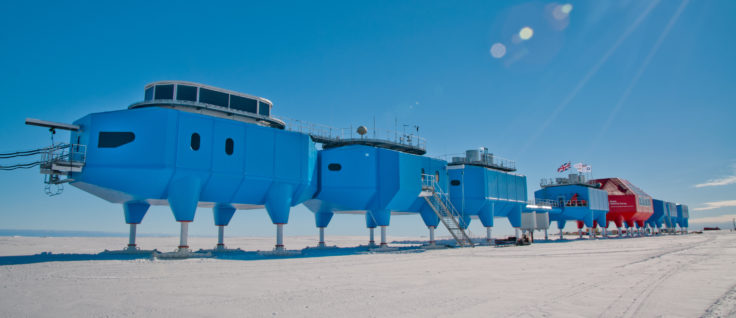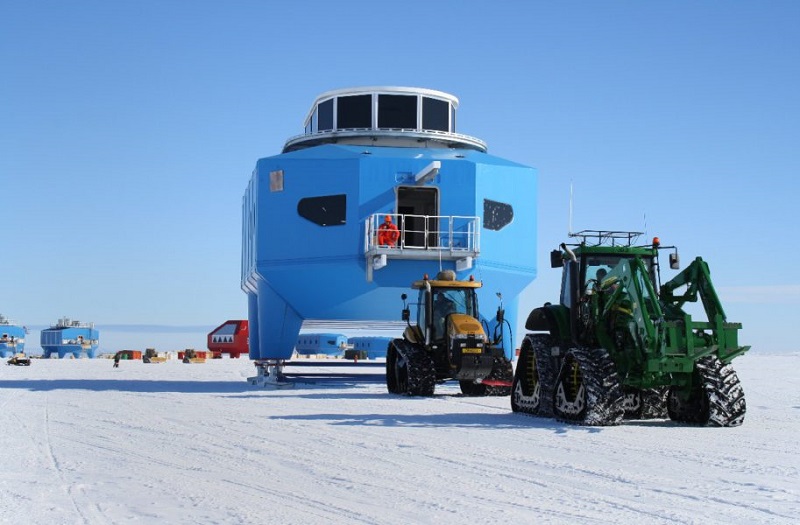Halley VI Research Station
In December 2016, the British Antarctic Survey (BAS) announced that due to a growing crack in the ice shelf, its Halley VI Research Station is to be moved. The station, which has a re-locatable design, is to be moved 23 km further inland. This is the first time it has had to move since it was towed into position on the Brunt Ice Shelf in 2012.
The station is crucial for studying globally important issues such as climate change and atmospheric phenomena. It is made up of eight modules which sit on skis. Each module is capable of being de-coupled from the others and towed by tractors across the ice. The station is designed and built to withstand extreme winter weather, to maintain excellent laboratory conditions, to provide accommodation, and is raised up to stay above the snow.
The crack in the ice has been growing for more than two years, with the tip moving gradually upstream of the station. It will take several years to cut the station off from the inland portion of the ice shelf if it continues to grow at its current rate, giving BAS time to relocate the station.
The relocation will be a slow process, with temporary camps being set up including containerised accommodation units for the relocation team. The relocation should be completed by 6 April 2018.
Tim Stockings, Director of Operations at BAS said:
“Halley was designed and engineered specifically to be re-located in response to changes in the ice. Over the last couple of years our operational teams have been meticulous in developing very detailed plans for the move and we are excited by the challenge.
“Antarctica can be a very hostile environment. Each summer season is very short – about 9 weeks. And because the ice and the weather are unpredictable we have to be flexible in our approach. We are especially keen to minimise the disruption to the science programmes. We have planned the move in stages – the science infrastructure that captures environmental data will remain in place while the stations modules move. ”
For more information, see British Antarctic Survey.
[edit] Find out more
[edit] Related articles on Designing Buildings Wiki
Featured articles and news
One of the most impressive Victorian architects. Book review.
RTPI leader to become new CIOB Chief Executive Officer
Dr Victoria Hills MRTPI, FICE to take over after Caroline Gumble’s departure.
Social and affordable housing, a long term plan for delivery
The “Delivering a Decade of Renewal for Social and Affordable Housing” strategy sets out future path.
A change to adoptive architecture
Effects of global weather warming on architectural detailing, material choice and human interaction.
The proposed publicly owned and backed subsidiary of Homes England, to facilitate new homes.
How big is the problem and what can we do to mitigate the effects?
Overheating guidance and tools for building designers
A number of cool guides to help with the heat.
The UK's Modern Industrial Strategy: A 10 year plan
Previous consultation criticism, current key elements and general support with some persisting reservations.
Building Safety Regulator reforms
New roles, new staff and a new fast track service pave the way for a single construction regulator.
Architectural Technologist CPDs and Communications
CIAT CPD… and how you can do it!
Cooling centres and cool spaces
Managing extreme heat in cities by directing the public to places for heat stress relief and water sources.
Winter gardens: A brief history and warm variations
Extending the season with glass in different forms and terms.
Restoring Great Yarmouth's Winter Gardens
Transforming one of the least sustainable constructions imaginable.
Construction Skills Mission Board launch sector drive
Newly formed government and industry collaboration set strategy for recruiting an additional 100,000 construction workers a year.
New Architects Code comes into effect in September 2025
ARB Architects Code of Conduct and Practice available with ongoing consultation regarding guidance.
Welsh Skills Body (Medr) launches ambitious plan
The new skills body brings together funding and regulation of tertiary education and research for the devolved nation.
Paul Gandy FCIOB announced as next CIOB President
Former Tilbury Douglas CEO takes helm.

























